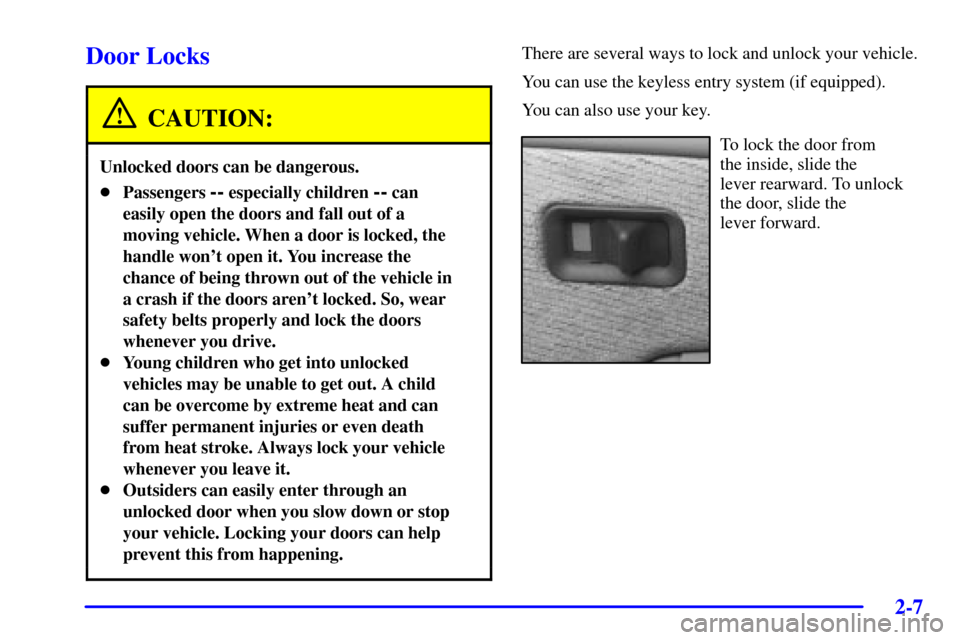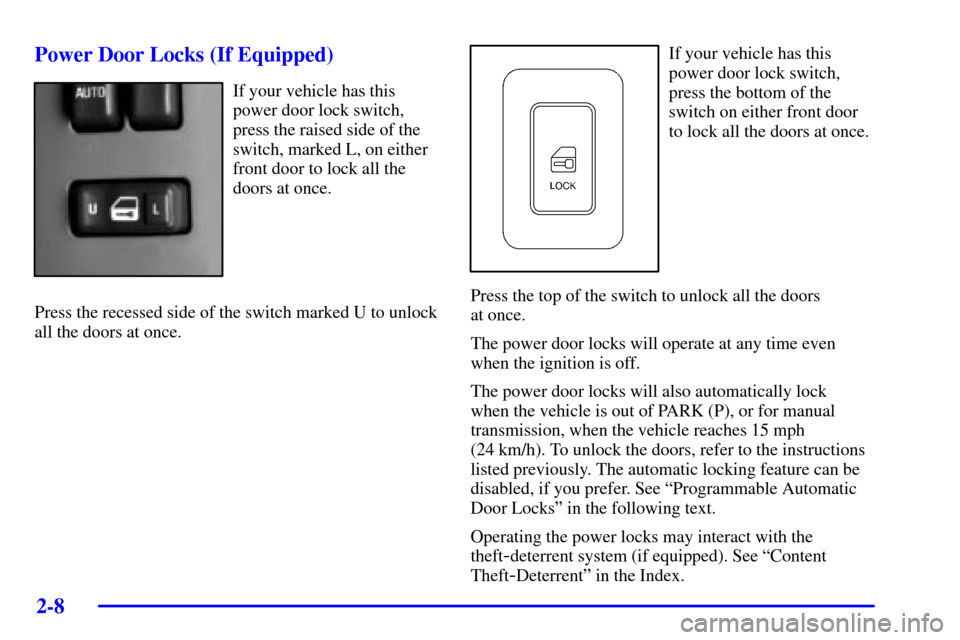Page 46 of 497
1-39
The safety belt locks if there's a sudden stop or a crash.
The safety belt also locks if you pull the belt very
quickly out of the retractor.
CAUTION:
You can be seriously hurt if your shoulder belt is
too loose. In a crash, you would move forward
too much, which could increase injury. The
shoulder belt should fit against your body.
To unlatch the belt, just push the button on the buckle.
Page 67 of 497
1-60
3. Buckle the belt. Make sure the release button is
positioned so you would be able to unbuckle the
safety belt quickly if you ever had to.4. Pull the rest of the shoulder belt all the way out of
the retractor to set the lock.
Page 75 of 497
1-68
5. Pull the rest of the shoulder belt all the way out of
the retractor to set the lock.6. To tighten the belt, feed the shoulder belt back
into the retractor while you push down on the
child restraint. If you're using a forward
-facing
child restraint, you may find it helpful to use your
knee to push down on the child restraint as you
tighten the belt.
7. Push and pull the child restraint in different
directions to be sure it is secure.
Page 81 of 497

2-
2-1
Section 2 Features and Controls
Here you can learn about the many standard and optional features on your vehicle, and information on starting,
shifting and braking. Also explained are the instrument panel and the warning systems that tell you if everything is
working properly
-- and what to do if you have a problem.
2
-2 Windows
2-5 Keys
2-7 Door Locks
2-12 Keyless Entry System (If Equipped)
2-15 Rear Doors
2-16 Tailgate
2-17 Theft
2-19 Content Theft-Deterrent (If Equipped)
2-20 Passlock�
2-21 New Vehicle ªBreak-Inº
2-21 Ignition Positions
2-24 Starting Your Engine
2-25 Engine Coolant Heater (If Equipped)
2-27 Automatic Transmission Operation
2-32 Manual Transmission Operation
2-37 Parking Brake
2-38 Shifting Into PARK (P)
(Automatic Transmission Only)
2
-41 Shifting Out of PARK (P)
(Automatic Transmission Only)2
-41 Parking Your Vehicle
(Manual Transmission Models Only)
2
-42 Parking Over Things That Burn
2-42 Engine Exhaust
2-43 Running Your Engine While You're Parked
(Automatic Transmission)
2
-44 Manual Selectable Ride (If Equipped)
2-45 Locking Rear Axle (If Equipped)
2-45 Four-Wheel Drive (If Equipped)
2-56 QUADRASTEER�(4WS) (If Equipped)
2-59 Turn Signal/Multifunction Lever
2-66 Exterior Lamps
2-71 Interior Lamps
2-73 Mirrors
2-90 OnStar� System (If Equipped)
2-94 The Instrument Panel - Your
Information System
2
-96 Instrument Panel Cluster
2-98 Warning Lights, Gages and Indicators
2-115 Message Center
Page 84 of 497
2-4
Lock-Out Switch
If you have power windows on a Crew Cab
�, the
driver's door power window switch has a lockout
feature. This feature prevents all windows from
operating, except from the driver's position, when the
driver's door button labeled WINDOW LOCK is
engaged. When the button is not engaged, the rear
power windows will operate.
Swing-Out Windows (Extended Cab)
To open a rear swing-out
window, flip the latch open
and swing the glass out.
The latch will catch when the window is fully open and
it will also hold it in the open position.
Page 86 of 497
2-6
Your vehicle has one
double
-sided key for the
ignition and all door locks.
Your vehicle may also have
a key that locks and unlocks
only the center floor
console (if equipped).If you ever lose your keys, your dealer will be able to
assist you with obtaining replacements.
NOTICE:
Your vehicle has a number of new features that
can help prevent theft. But you can have a lot of
trouble getting into your vehicle if you ever lock
your key inside. You may even have to damage
your vehicle to get in. So be sure you have an
extra key.
If you ever do get locked out of your vehicle, call the
GM Roadside Assistance Center. See ªRoadside
Assistanceº in the Index. If your vehicle is equipped
with the OnStar system with an active subscription and
you lock your keys inside the vehicle, OnStar may be
able to send a command to unlock your vehicle. See
ªOnStarº in the Index for more information.
Page 87 of 497

2-7
Door Locks
CAUTION:
Unlocked doors can be dangerous.
�Passengers -- especially children -- can
easily open the doors and fall out of a
moving vehicle. When a door is locked, the
handle won't open it. You increase the
chance of being thrown out of the vehicle in
a crash if the doors aren't locked. So, wear
safety belts properly and lock the doors
whenever you drive.
�Young children who get into unlocked
vehicles may be unable to get out. A child
can be overcome by extreme heat and can
suffer permanent injuries or even death
from heat stroke. Always lock your vehicle
whenever you leave it.
�Outsiders can easily enter through an
unlocked door when you slow down or stop
your vehicle. Locking your doors can help
prevent this from happening.
There are several ways to lock and unlock your vehicle.
You can use the keyless entry system (if equipped).
You can also use your key.
To lock the door from
the inside, slide the
lever rearward. To unlock
the door, slide the
lever forward.
Page 88 of 497

2-8
Power Door Locks (If Equipped)
If your vehicle has this
power door lock switch,
press the raised side of the
switch, marked L, on either
front door to lock all the
doors at once.
Press the recessed side of the switch marked U to unlock
all the doors at once.
If your vehicle has this
power door lock switch,
press the bottom of the
switch on either front door
to lock all the doors at once.
Press the top of the switch to unlock all the doors
at once.
The power door locks will operate at any time even
when the ignition is off.
The power door locks will also automatically lock
when the vehicle is out of PARK (P), or for manual
transmission, when the vehicle reaches 15 mph
(24 km/h). To unlock the doors, refer to the instructions
listed previously. The automatic locking feature can be
disabled, if you prefer. See ªProgrammable Automatic
Door Locksº in the following text.
Operating the power locks may interact with the
theft
-deterrent system (if equipped). See ªContent
Theft
-Deterrentº in the Index.